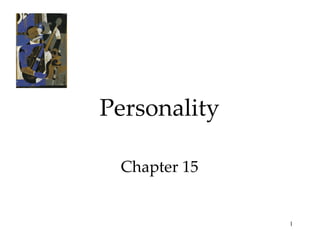
Chapter15
- 14. Model of Mind The mind is like an iceberg. It is mostly hidden, and below the surface lies the unconscious mind. The preconscious stores temporary memories.
- 18. Psychosexual Stages Freud divided the development of personality into five psychosexual stages.
- 22. Defense Mechanisms 3. Reaction Formation causes the ego to unconsciously switch unacceptable impulses into their opposites. People may express feelings of purity when they may be suffering anxiety from unconscious feelings about sex. 4. Projection leads people to disguise their own threatening impulses by attributing them to others.
- 23. Defense Mechanisms 5. Rationalization offers self-justifying explanations in place of the real, more threatening, unconscious reasons for one’s actions. 6. Displacement shifts sexual or aggressive impulses toward a more acceptable or less threatening object or person, redirecting anger toward a safer outlet.
- 44. Factor Analysis Cattell found that large groups of traits could be reduced down to 16 core personality traits based on statistical correlations. Impulsive Excitement Impatient Irritable Boisterous Basic trait Superficial traits
- 50. Endpoints
- 51. Questions about the Big Five Yes. Conscientious people are morning type and extraverted are evening type. 4. Can they predict other personal attributes? These traits are common across cultures. 3. How about other cultures? Fifty percent or so for each trait. 2. How heritable are they? Quite stable in adulthood. However, they change over development. 1. How stable are these traits?
Notes de l'éditeur
- OBJECTIVE 1 | Define personality .
- OBJECTIVE 2 | Explain how Freud’s experiences in private practice led to his theory of psychoanalysis.
- OBJECTIVE 3 | Discuss Freud’s view of the mind as an iceberg, and explain how he used this image to represent conscious and unconscious regions of the mind.
- OBJECTIVE 4 | Describe Freud’s view of personality structure, and discuss the interactions of the id, ego and the superego.
- OBJECTIVE 5 | Identify Freud’s psychosexual stages of development, and describe the effects of fixation on behavior.
- OBJECTIVE 6 | Describe the function of defense mechanisms, and identify six of them.
- OBJECTIVE 7 | Contrast the views of the neo-Freudians and psychodynamic theorists with those of Freud’s original theory.
- OBJECTIVE 8 | Describe two projective tests used to assess personality, and discuss some criticisms of them.
- OBJECTIVE 9 | Summarize psychology’s current assessment of Freud’s theory of psychoanalysis.
- OBJECTIVE 10 | Summarize Abraham Maslow’s concept of self-actualization, and explain how his ideas illustrate the humanistic perspective.
- OBJECTIVE 11 | Discuss Carl Roger’s person-centered perspective, and explain the importance of unconditional positive regard.
- OBJECTIVE 12 | Explain how humanistic psychologists assessed personality.
- OBJECTIVE 13 | State the major criticism of the humanistic perspective on personality.
- OBJECTIVE 14 | Describe the trait and perspective’s contribution to personality research.
- OBJECTIVE 15 | Describe some of the ways psychologists have attempted to compile a list of basic personality traits.
- OBJECTIVE 16 | Explain how psychologists use personality inventories to assess traits, and discuss the most widely used of these inventories.
- OBJECTIVE 17 | Identify the Big Five personality factors, and discuss some of the strengths of this approach to studying personality.
- OBJECTIVE 18 | Summarize the person-situation controversy, and explain its importance as a commentary on the trait perspective.
- OBJECTIVE 19 | Explain why psychologists are interested in the consistency of the trait expressiveness.
- OBJECTIVE 20 | Define reciprocal determinism, and explain how it illustrates the social-cognitive perspective.
- OBJECTIVE 21 | Discuss the effects of a perception of internal or external control, and describe the concept of learned helplessness.
- OBJECTIVE 22 | Discuss the link between performance and optimistic or pessimistic attributional styles, and contrast positive psychology with humanistic psychology.
- OBJECTIVE 23 | Explain why social-cognitive researchers assess behavior in realistic situations.
- OBJECTIVE 24 | Summarize the criticisms of the social-cognitive perspective.
- OBJECTIVE 25 | Explain why psychology has generated so much research on the self, and give three examples of current research on the self.
- OBJECTIVE 26 | Give two alternative explanations for the positive correlation between low self-esteem and personal problems.
- OBJECTIVE 27 | Discuss some ways in which people maintain their self-esteem under conditions of discrimination or low status.
- OBJECTIVE 28 | Discuss some evidence for self-serving bias, and contrast defensive and secure self-esteem.